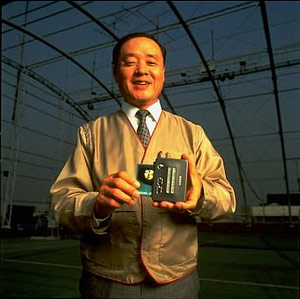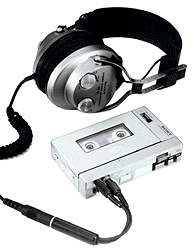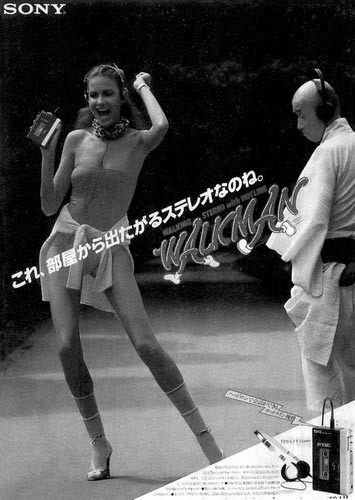| |

device, which derived to
the actual flash player.
Text copied
from the Wikipedia:
The metal-cased blue-and-silver Walkman TPS-L2, the world's first
low-cost portable stereo, went on sale in Japan on July 1, 1979.
In June 1980, it was introduced in the U.S. In the UK, it came
with stereo playback and two mini headphone jacks, permitting two
people to listen at the same time (though it came with only one
pair of MDR-3L2 headphones). Where the Pressman had
the recording button, the TPS-L2 had a "hotline" button which
activated a small built-in microphone, partially overriding the
sound from
the cassette, and allowing one user to talk to the other over the
music. Originally marketed as the "Soundabout" in the
U.S., the "Stowaway" in the U.K., and the "Freestyle" in
Sweden, SONY soon had the new name "Walkman" embossed
into the metal tape cover of the device. When the follow-up model, "Walkman
II" came out, the "hotline" button was phased out.
The TPS-L2 was created by Akio Morita, Masaru Ibuka (the co-founders
of SONY) and Kozo Ohsone.
Text copied
from LowEndMac:
(images added by me)
There were some cassette recorders available at the time, although
they were not designed for the general public. SONY called theirs
Pressman and marketed it exclusively to reporters. These recorders
lacked stereo sound and were very expensive. They also used (typically)
microcassettes, which had no support from record companies (and were
expensive to boot).
With the limited choices presented to consumers,
the most popular cassette tape players were either home stereos or
car players.
SONY Enters the Market
SONY's first stab at the personal tape
player market came in 1978, with the TC-D5. It had excellent quality
sound (surpassing most
HI-FI decks) and was easy to operate. Unfortunately for most
potential customers, the price was around $1,000 (¥300,000),
and it was hardly portable.

One regular user was Ibuka, then SONY's
honorary chairman. He used the player on airplane trips, but
he found the player too
heavy for everyday use. He instructed the tape recorder division
to create a smaller version for his personal use.
The division, led
by Kozo Ohsone, modified a Pressman to do the job. They
removed the record function and added stereophonic sound.
Ibuka was
immediately impressed and suggested that they bring a similar item
to market.

Kozo Ohsone, SONY co-founder.
By 1979, SONY's tape recorder division was
flagging. There was little demand for their high-end products,
while products from
competing lines succeeded (boom boxes, etc.). In February, 1979,
Morita, the company's chairman, encouraged the engineers to develop
a player similar to the one they had developed for Ibuka. But
this one had to cost less than ¥40,000 yet provide the same
sound quality. He wanted the product by June 21, 1979.
Though he was skeptical
that the division could create a player so quickly, Kozo Ohsone
was eager to avoid having the division
consolidated into another division (SONY was going through a
reorganization at the time) and quickly designed a portable tape
player based
on Ibuka's modified Pressman player. They used lower end components
to bring the price down and encased it in a small, stylish enclosure.
The Right Name
There was a problem: the device didn't have
a name. Ohsone suggested that they use the name "Walkman",
a play on the Pressman, but the company's leadership was
skeptical. The name sounded
like a straight Japanese translation, and they feared it would
not catch on in the US and Europe. Several other
names were suggested.
Walky was the most popular, but none were as memorable
as Walkman,
so the name stayed.

The first WALKMAN logo.
Morita was worried that the device wouldn't
appeal to the young or active because of the headphones. They
were far larger than
the player (they weighed more than 400 grams) and were more like
earmuffs than today's headphones.

Three
years before, SONY engineers in another division had designed a
lightweight pair of headphones.
They eliminated the large, enclosed
earpiece and in its place put soft foam. Ueyema decided that
he could make the Walkman more of a personal player by including
these
smaller headphones. A listener could now use a tape player while
in motion without disturbing those around him or her. The new
headphones weighed around 50 grams.
Enter the Walkman
On June 21, 1979 the Walkman was announced to
the public. Before
the new player was available to the public, the press lampooned
it. Some claimed that nobody would be interested in a tape player
without a record function. Others pointed out that the most popular
tape recorder of the time had sold less than 15,000 units, and
SONY had produced 30,000.
The company was unfazed by such criticism
and pushed on with promotion. SONY distributed the player to
young people and celebrities around
Japan, generating demand.
To promote the device amongst younger Japanese,
SONY hired young people to walk through the Ginza, offering passersby
to listen
to the Walkman's excellent audio quality. Instead of having
a conventional introduction to the press, SONY arranged a bus tour
with actors throughout
Tokyo posing with the
Walkman while the reporters listened to a recorded tour.

World's first Walkman Ad in the history. Only seen in Japan.
A month after
the Walkman became available in Japanese stores, it was
sold out. The device was popular amongst all consumers,
not just those under 20. SONY had succeeded at creating a personal
audio player, and it prepared to launch the product in Europe
and North America.
Earlier apprehensions about the name reappeared, and
the marketing department decided to rename the product Freestyle in
Sweden, Storaway in the UK, and Soundabout in
the US. However, during a visit to SONY employees in Paris, Morita
was asked by employee's children
when they could get their Walkman, and the Japanese name
stuck.

After some time, SONY changed the original logo to the actual one
and made a 2nd generation TPS-L2, with the new logo.
From left to right: TCM-600, original TPS-L2 and 2nd generation.
Photo: Eric Wrobbel, used with permission.
In
ten years SONY sold 50 million units, and competitors had sold
countless knockoffs. The term "Walkman" even entered
our language, used to describe any cassette player, and it's
listed as such in the Oxford English Dictionary.
|
|
![]()
![]()
![]()